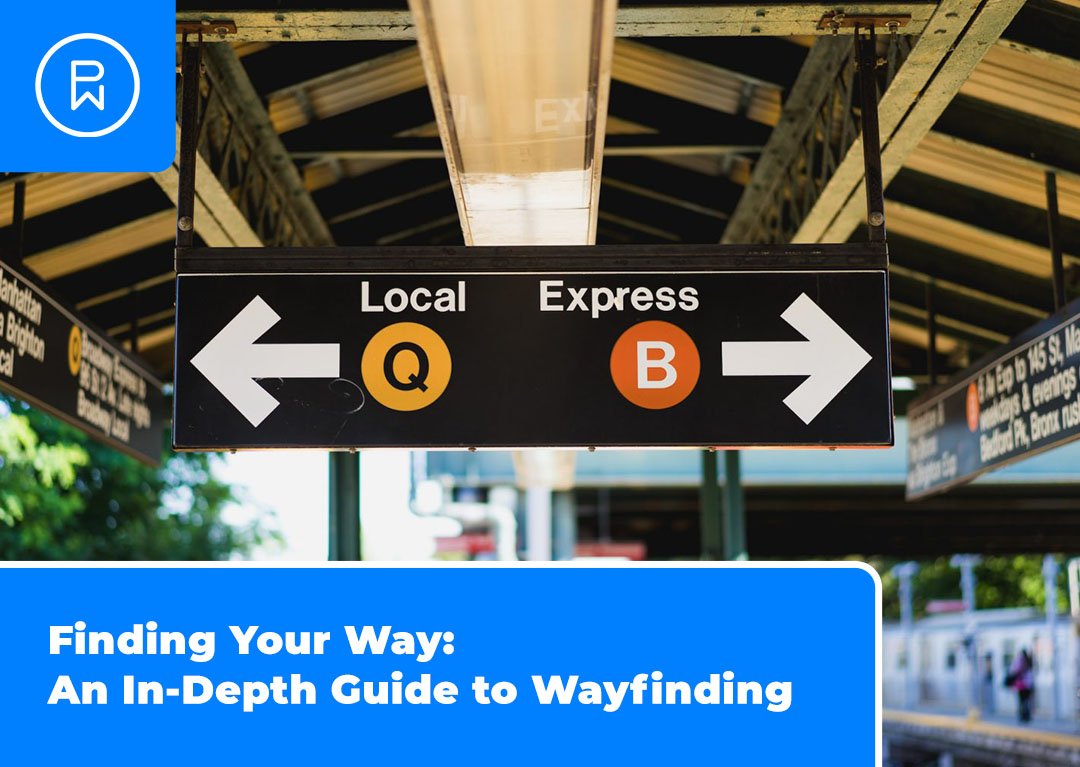Have you ever found yourself lost in a maze-like shopping mall, or wandering around a large hospital with no clue where to go next? If so, you’ve experienced the frustration that poor wayfinding can cause.
Wayfinding is the process by which people orient themselves in physical space and navigate from one location to another. It’s like a compass for your brain, guiding you through unfamiliar territory.
Long before GPS and digital maps, people relied on natural landmarks, celestial navigation, and even the behavior of animals to find their way. Fast forward to today, and wayfinding has evolved into a multidisciplinary field that encompasses everything from signage and maps to architectural design and technology.
In this blog post, we will explore the fundamentals and complexities of wayfinding and share effective strategies for designing a functioning wayfinding system. We’ll also cover:
- Types of wayfinding
- How wayfinding exists in different environments
- Wayfinding and how it relates to user experience (UX), accessibility, and technology.
Elements of Wayfinding
Wayfinding is an essential component of any environment, as it helps people to navigate their way around buildings, cities, and other spaces. The elements of effective wayfinding are
- Signage – one of the most important elements of wayfinding. Well-designed signs can help people quickly and easily find their way to their destination. Signs should be clear, concise, and easy to read. They should also be consistent in their design and placement.
- Lighting – well-lit spaces are easier to navigate than dark spaces. Lighting can also be used to highlight landmarks and other important features in a space.
- Color – aids wayfinding by creating visual cues that help people to orient themselves in a space. For example, a common way to indicate the direction of travel is to use a consistent color scheme for directional signs.
- Materials – the materials used in a space can also affect its wayfinding properties. For example, smooth surfaces are easier to navigate than rough surfaces. Materials can also be used to create visual interest and to help people to orient themselves in a space.
- Architecture – well-designed buildings and other structures can help people easily find their way around. For example, open floor plans with clear sightlines make it easier for people to see where they are going.
- Technology – technologies such as digital maps and real-time navigation via GPS, beacons, and WiFi can help people to find their way around even in unfamiliar places.
Types of Wayfinding
As people navigate through various environments, it’s crucial to have effective wayfinding systems in place. However, not all spaces are the same, and different situations call for different types of wayfinding solutions. The types of wayfinding available include:
Static Wayfinding
The most traditional form of wayfinding. This type includes physical signs, maps, other non-digital elements and static digital images that provide users with essential information about their surroundings. These systems are cost-effective and need little maintenance, making them popular choices for many environments. However, they may not be as versatile or adaptable as some of the more advanced options.
Dynamic Wayfinding
A newer type of wayfinding that uses technology to help people find their way. Dynamic wayfinding systems use digital technology to display real-time information and updates. Examples include digital screens showing live transportation schedules or directories that can be updated remotely. This type of wayfinding is more flexible than static systems, as the information can be easily changed to reflect current conditions or events.
Interactive Wayfinding
A type of wayfinding that takes user engagement to the next level by allowing users to interact with the system and receive personalized guidance. This can include blue-dot wayfinding, touchscreen kiosks, mobile apps, or even augmented reality experiences.
Interactive systems provide users with more detailed information and tailored directions, improving overall navigation efficiency and satisfaction.
Auditory Wayfinding
A type of wayfinding that uses sound to help people find their way. Auditory wayfinding can be used in conjunction with static wayfinding to provide a more accessible wayfinding experience for people with visual impairments. Examples of auditory wayfinding include spoken directions from a mobile app or strategically placed speakers that emit distinctive sounds to guide users along a path.
Wayfinding in Different Environments
Different environment presents unique challenges and requirements, making it crucial to tailor wayfinding solutions to meet specific needs.
Hospitals
Hospitals and healthcare facilities are often large and complex, with many different departments and services. Wayfinding can help patients, visitors, and staff to find their way around the facility quickly and easily thereby reducing stress and confusion.
Hotel and Resorts
Hotels and resorts are complex environments that often encompass a wide range of facilities and amenities, such as guest rooms, restaurants, conference halls, spas, and recreational areas. Wayfinding signs and directions in this type of environment is integral for guests and staff to easily move around and find their way to their destination. A great wayfinding system for hotels will integrate signage with maps, digital kiosks, and apps to provide guests with detailed information about the area.
Airports
Effective wayfinding in airports helps to ensure a smooth travel experience. With thousands of passengers navigating through terminals, security checkpoints, and boarding gates, airport wayfinding should cater to these diverse audiences, using clear signage, digital displays, and interactive kiosks to provide real-time information and directions.
Shopping Centers and Malls
Malls and shopping centers can be overwhelming for visitors due to their size and complexity. A well-designed wayfinding system can enhance the shopping experience by guiding visitors to stores, restrooms, and other amenities. Incorporating digital directories and interactive maps can also help users find their desired locations quickly and efficiently.
Universities and Educational Institutions
Navigating sprawling campuses can be challenging for students, faculty staff, and visitors alike. A comprehensive wayfinding system will enable its users to locate classrooms, administrative offices, and other facilities. By combining static signage with digital solutions, universities can create an intuitive navigation experience that caters to the needs of their diverse populations.
Urban Environments
Urban environments present unique wayfinding challenges due to their scale and complexity. Public spaces, parks, and transportation hubs all require effective wayfinding systems to guide users through the city. Integrating traditional signage with digital solutions, such as mobile apps and interactive kiosks, can create a seamless navigation experience that connects people to their surroundings.
Designing Effective Wayfinding Systems
The foundation of an effective wayfinding system lies in understanding the people who will use it. Consider factors such as age, cultural background, and accessibility needs when designing your system. Observe how users navigate your space and identify any areas where they may struggle or become disoriented. For example, a hospital may have patients with mobility issues, requiring clear paths and easy-to-understand signage.
Once you understand user needs and behavior, the next step is to develop a wayfinding strategy. This strategy should outline the goals of the wayfinding system, as well as the specific steps that you’ll take to achieve those goals. The wayfinding strategy should also be aligned with the overall design of the space.
After developing a strategy, make sure to collaborate with stakeholders like architects, engineers, and other professionals who are involved in the design of the space. Stakeholders can provide valuable input on the wayfinding system, and they can also help to ensure that the system is implemented correctly.
The final step in designing an effective wayfinding system is to incorporate sustainability. This can be done by using materials that are environmentally friendly, and by designing the system in a way that minimizes its impact on the environment. Sustainable wayfinding not only benefits the environment but can also enhance your organization’s reputation and appeal to eco-conscious users.
Wayfinding and Accessibility
Creating an inclusive environment is essential for any public space, and wayfinding plays a significant role in ensuring accessibility for all users.
Individuals with disabilities may face unique challenges when navigating public spaces. For example, visually impaired users may struggle to read standard signage, while those with mobility impairments may require ramps or elevators to navigate different levels. Understanding these challenges is crucial for designing a wayfinding system that accommodates the needs of all users.
Adopting a Universal Design – an approach to design that considers the needs of all users, including people with disabilities, can help to create wayfinding systems that are accessible to everyone. Therefore, ensuring it is both functional for users with disabilities and intuitive and efficient for all other users.
In many countries, there are legal requirements for public spaces to be accessible to individuals with disabilities. For example, the Americans with Disabilities Act (ADA) in the United States sets specific guidelines for signage, pathways, and other elements to ensure accessibility. Complying with these regulations is not only a legal obligation but also a demonstration of your commitment to inclusivity.
Best Practices for Inclusive Wayfinding
To create a truly inclusive wayfinding system, consider the following best practices:
- Use clear, high-contrast signage with large fonts and symbols that are easy to read.
- Incorporate tactile elements, such as Braille or raised lettering, to assist visually impaired users.
- Include auditory cues, such as spoken directions to guide users with visual impairments.
- Ensure pathways are wide enough to accommodate wheelchairs and provide ramps or elevators where necessary.
- Provide clear, easy-to-understand information about accessible routes, entrances, and facilities.
Wayfinding Technology
Technology is revolutionizing wayfinding, providing innovative solutions that enhance user experience and streamline navigation. Here are some of the ways technology has improved wayfinding:
Digital Signage and Displays
Digital signage and displays offer dynamic, real-time information to users, making them an essential component of modern wayfinding systems.
Mobile Applications
Mobile applications have become increasingly popular for wayfinding, as they provide users with personalized, on-the-go navigation assistance. By utilizing GPS technology, beacons, and WiFi signals, mobile apps can offer turn-by-turn directions, location-based recommendations, and even real-time updates on accessibility features.
Augmented Reality (AR)
Augmented reality is an emerging technology that superimposes digital elements onto the user’s view of the physical world. In wayfinding, AR can provide users with visual routes as they walk or navigate through an environment. Popular AR apps like Pokemon Go showcase the immense potential of this technology in the wayfinding domain.
Artificial Intelligence (AI)
Artificial intelligence has made significant strides in recent years, including in wayfinding. AI-powered chatbots and virtual assistants can understand and respond to natural language queries, helping users find their way by providing personalized guidance and recommendations based on their current location. AI can also recommend the best route to a destination based on the user’s preferences and the current traffic conditions.
Smart Cities
As cities become smarter and more connected, wayfinding is set to reach new heights. According to research, the global smart city market is expected to reach $820.7 billion by 2025. This growth is driven by the integration of IoT devices and sensors, enabling real-time data collection and analysis, which greatly enhances wayfinding capabilities.
In a smart city, digital kiosks, connected streetlights, and other infrastructure can communicate with each other and with users, making navigation seamless and efficient.
Wayfinding and User Experience
User experience (UX) is the experience a user has with a product or service. It includes the way the product or service is designed, how easy it is to use, and how enjoyable it is to use.
Leveraging a user-centered design helps you to focus on the needs of users and create a positive user experience with a wayfinding system.
The Benefits of Positive User Experience
A positive user experience has the following benefits:
- Increased satisfaction from using a product or service
- Increased loyalty to a brand
- Increased recommendation via word-of-mouth and social media.
The wayfinding experience can have a significant impact on users. When users are able to find their way without stress, they feel confident and in control. However, when users get lost or confused, they can feel frustrated and anxious.
The emotional impact of wayfinding can be influenced by a number of factors, including the design of the wayfinding system, the user’s familiarity with the environment, and the user’s individual personality.
Case Studies of Successful Wayfinding and User Experience
Case Study 1: Virginia Hospital Center
An incredible case study of a successful wayfinding system is Phunware’s powerful healthcare solution for Virginia Hospital Center (VHC). We provided VHC Health with wayfinding solutions to enable their patients, visitors, and staff to access interactive maps that direct them to their destinations in real time.
The wayfinding solutions work on both iPhones and Android devices and enhance navigation around the VHC Health facility including floor levels.
Case Study 2: Atlantis Paradise Island Resort
Another interesting case study is how Phunware’s tech helped Atlantis Paradise Island to offer both its staff and guests a sophisticated mobile engagement platform. The solution helped to enhance the Atlantis brand experience by providing their guests with Location-Based Services (LBS), interactive mapping, wayfinding, and indoor positioning, thereby improving operational and staff efficiencies.
Future of Wayfinding
New technologies are constantly reshaping the wayfinding landscape, offering exciting possibilities for the future. Some notable advancements include:
- Geofencing: current developments in geofencing will strengthen hotels, resorts, and healthcare organizations in providing more personalized services for their guests such as location-based services (LBS).
- Beacon Technology: Beacons use Bluetooth signals to transmit information to smartphones, enabling real-time indoor navigation and personalized experiences and marketing based on user location.
- Virtual Reality (VR): VR has the potential to revolutionize wayfinding by allowing users to explore and familiarize themselves with an environment before physically visiting it.
- Autonomous Vehicles: As self-driving cars become more prevalent, wayfinding systems will need to adapt to facilitate seamless navigation and communication between vehicles and infrastructure.
The future of wayfinding presents opportunities for innovation such as harnessing the power of data analytics and machine learning to create smarter and more personalized wayfinding systems. It’s also possible to integrate game-like elements into wayfinding to make navigation more engaging and enjoyable thus, encouraging users to explore their surroundings and discover new experiences.
Conclusion
Effective wayfinding is essential for any environment as it helps people to navigate their way around environments easily. The elements of effective wayfinding include signage, lighting, color, materials, architecture, and technology. They can be used individually or in conjunction with one another for different environments.
User experience is an important component of wayfinding as it enhances the creation of a smooth and enjoyable navigation experience. Creating an inclusive environment is essential for any public space, and this should include making sure wayfinding systems are accessible to everyone.
Technology is revolutionizing wayfinding, providing innovative solutions that enhance user experience and streamline navigation.
The future of wayfinding presents opportunities for innovation and greater sustainability, and the use of data analytics and machine learning can create smarter and more personalized ways of navigating around an environment.
By now, you’d have understood that effective wayfinding is essential for a variety of environments and to create an efficient and inclusive wayfinding system, you must ensure that users’ preferences and needs are taken into account.
If you’re looking to reduce the stress and frustration of patients, clients, visitors, and users, or you’d like to improve your existing wayfinding system to incorporate the latest technologies, Phunware provides wayfinding development solutions for organizations to enable them to provide users with the state-of-the-art navigation experience.







